MKT9617 - Buyer Behaviour Analysis of Singapore Airlines Report.
VerifiedAdded on 2023/04/25
|24
|4897
|285
Report
AI Summary
This report analyzes the marketing challenges faced by Singapore Airlines, particularly in selling premium economy class seats on long-haul flights. It includes a buyer behavior analysis, a multi-dimensional profile of the target market, and an evaluation of key influences on the decision-making process. The report also proposes a communication strategy employing various media and messaging techniques to address information processing issues. A creative marketing campaign leveraging social media and strategic partnerships is suggested to promote the premium economy class, targeting both new and existing customers by highlighting its value and comfort. The communication mix strategy focuses on incentives and seamless booking management to improve sales and customer satisfaction.
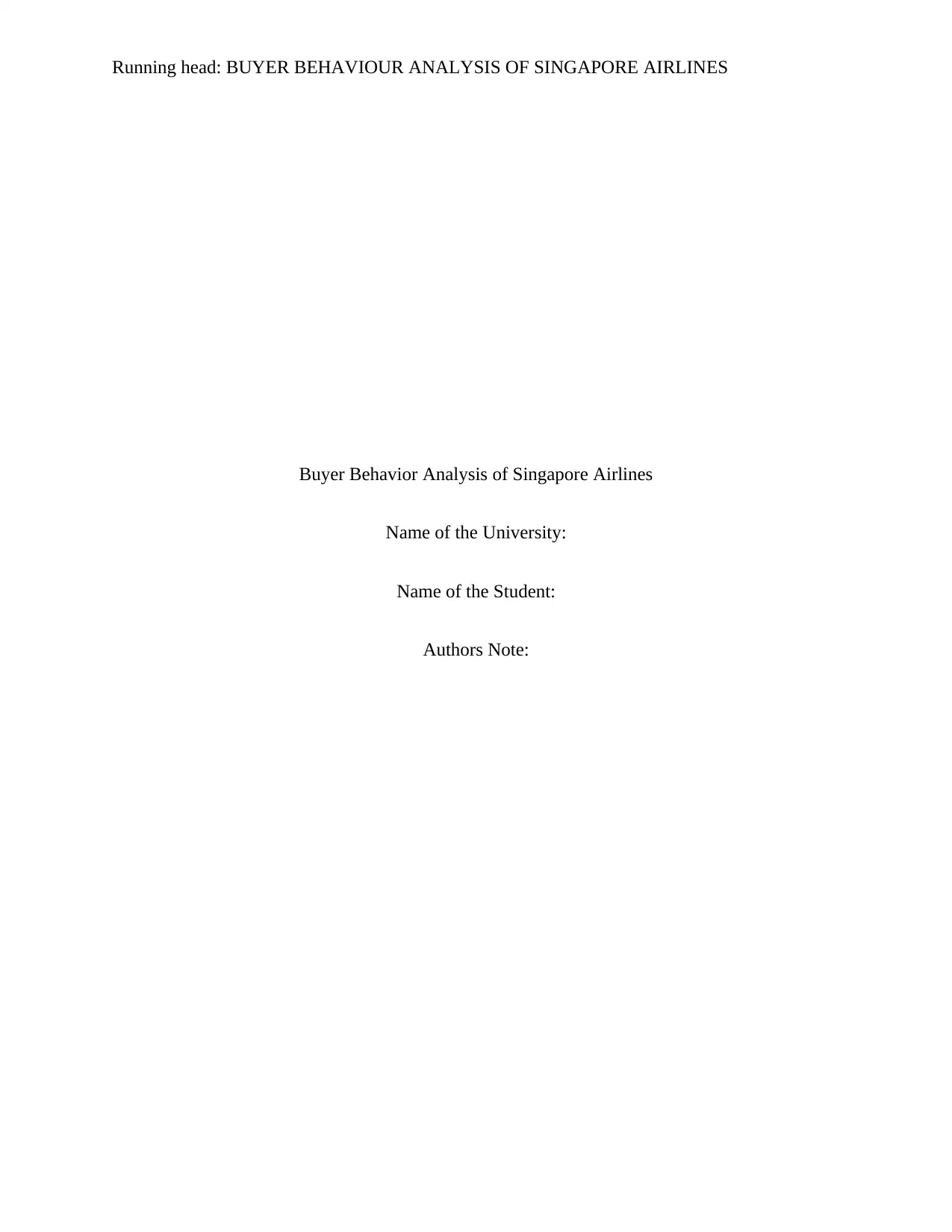
Running head: BUYER BEHAVIOUR ANALYSIS OF SINGAPORE AIRLINES
Buyer Behavior Analysis of Singapore Airlines
Name of the University:
Name of the Student:
Authors Note:
Buyer Behavior Analysis of Singapore Airlines
Name of the University:
Name of the Student:
Authors Note:
Paraphrase This Document
Need a fresh take? Get an instant paraphrase of this document with our AI Paraphraser
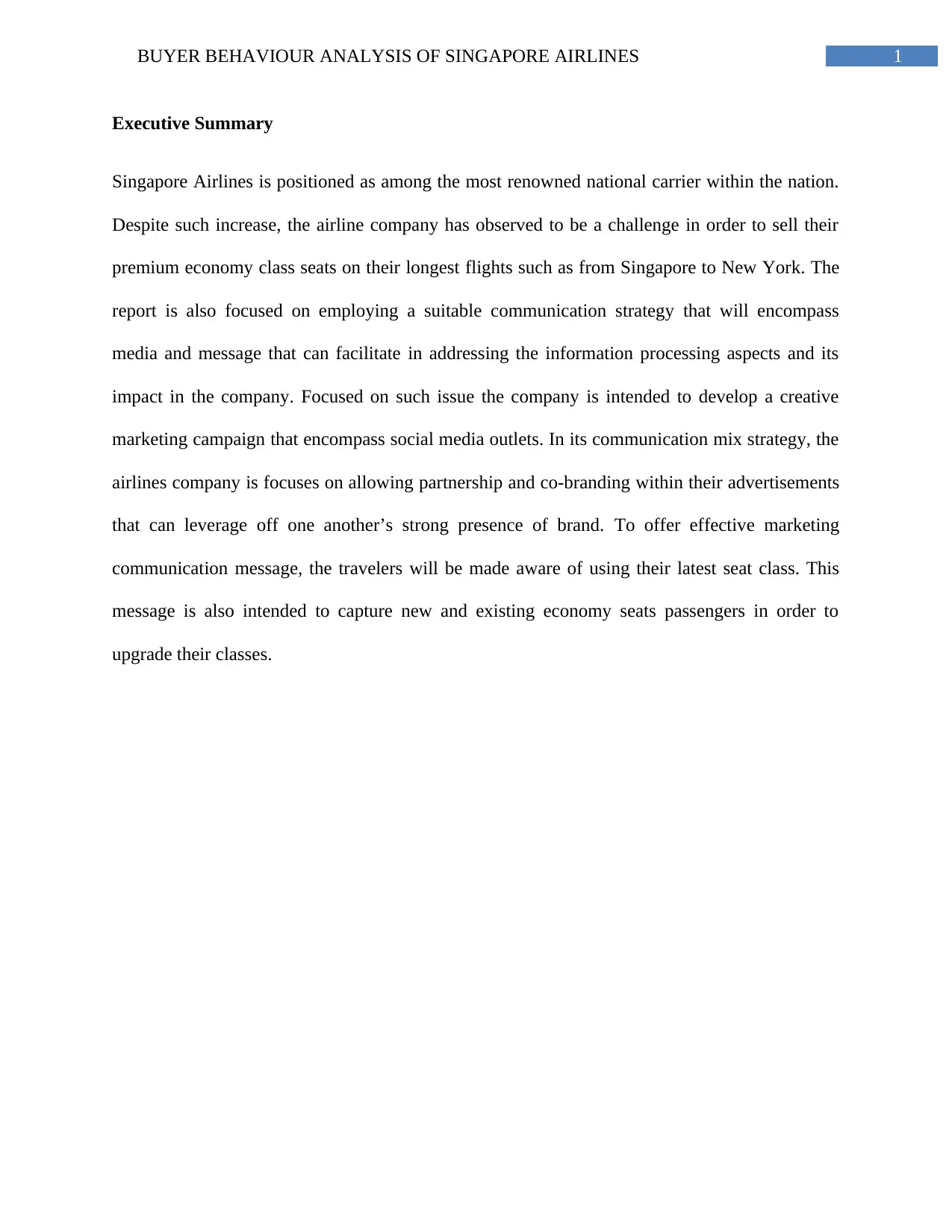
1BUYER BEHAVIOUR ANALYSIS OF SINGAPORE AIRLINES
Executive Summary
Singapore Airlines is positioned as among the most renowned national carrier within the nation.
Despite such increase, the airline company has observed to be a challenge in order to sell their
premium economy class seats on their longest flights such as from Singapore to New York. The
report is also focused on employing a suitable communication strategy that will encompass
media and message that can facilitate in addressing the information processing aspects and its
impact in the company. Focused on such issue the company is intended to develop a creative
marketing campaign that encompass social media outlets. In its communication mix strategy, the
airlines company is focuses on allowing partnership and co-branding within their advertisements
that can leverage off one another’s strong presence of brand. To offer effective marketing
communication message, the travelers will be made aware of using their latest seat class. This
message is also intended to capture new and existing economy seats passengers in order to
upgrade their classes.
Executive Summary
Singapore Airlines is positioned as among the most renowned national carrier within the nation.
Despite such increase, the airline company has observed to be a challenge in order to sell their
premium economy class seats on their longest flights such as from Singapore to New York. The
report is also focused on employing a suitable communication strategy that will encompass
media and message that can facilitate in addressing the information processing aspects and its
impact in the company. Focused on such issue the company is intended to develop a creative
marketing campaign that encompass social media outlets. In its communication mix strategy, the
airlines company is focuses on allowing partnership and co-branding within their advertisements
that can leverage off one another’s strong presence of brand. To offer effective marketing
communication message, the travelers will be made aware of using their latest seat class. This
message is also intended to capture new and existing economy seats passengers in order to
upgrade their classes.
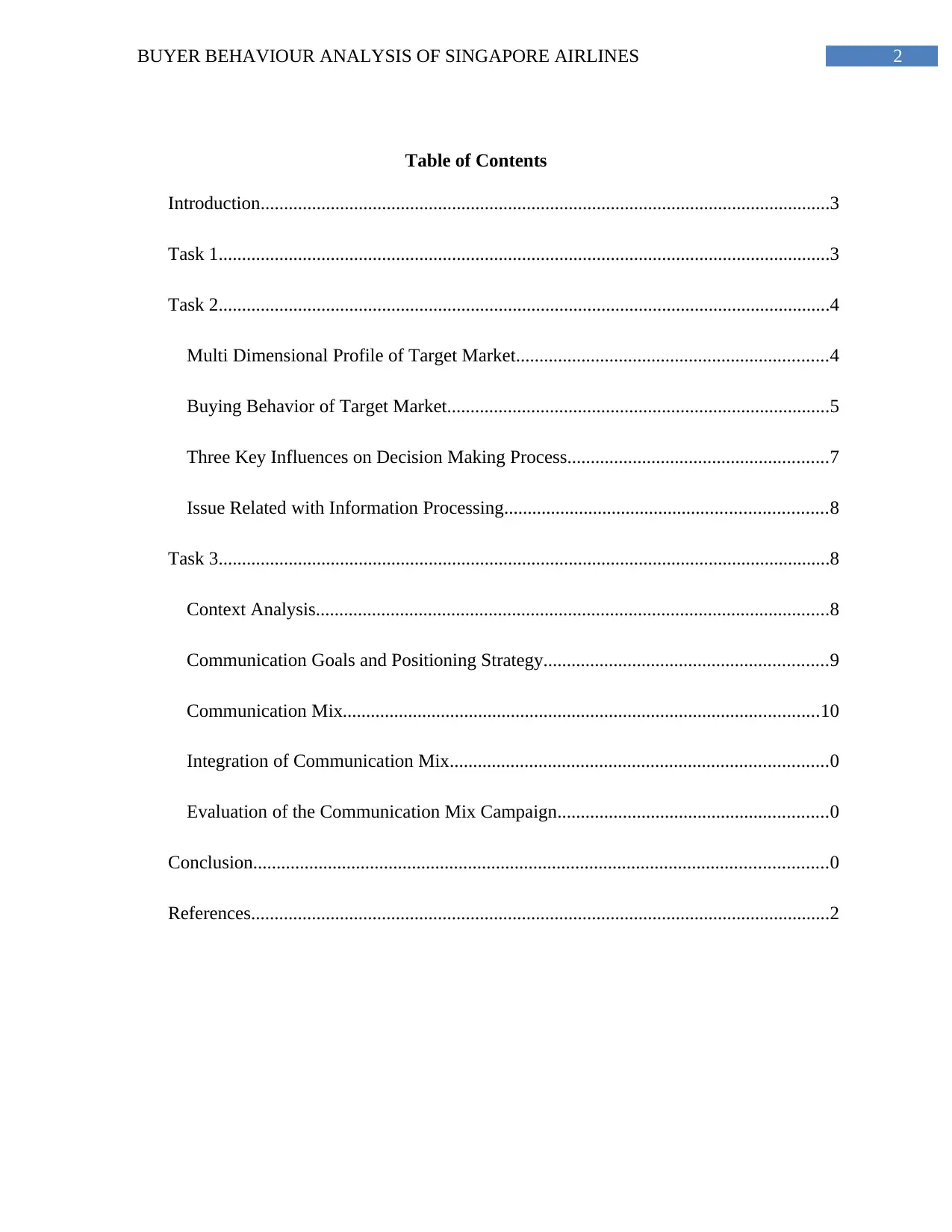
2BUYER BEHAVIOUR ANALYSIS OF SINGAPORE AIRLINES
Table of Contents
Introduction..........................................................................................................................3
Task 1...................................................................................................................................3
Task 2...................................................................................................................................4
Multi Dimensional Profile of Target Market...................................................................4
Buying Behavior of Target Market..................................................................................5
Three Key Influences on Decision Making Process........................................................7
Issue Related with Information Processing.....................................................................8
Task 3...................................................................................................................................8
Context Analysis..............................................................................................................8
Communication Goals and Positioning Strategy.............................................................9
Communication Mix......................................................................................................10
Integration of Communication Mix.................................................................................0
Evaluation of the Communication Mix Campaign..........................................................0
Conclusion...........................................................................................................................0
References............................................................................................................................2
Table of Contents
Introduction..........................................................................................................................3
Task 1...................................................................................................................................3
Task 2...................................................................................................................................4
Multi Dimensional Profile of Target Market...................................................................4
Buying Behavior of Target Market..................................................................................5
Three Key Influences on Decision Making Process........................................................7
Issue Related with Information Processing.....................................................................8
Task 3...................................................................................................................................8
Context Analysis..............................................................................................................8
Communication Goals and Positioning Strategy.............................................................9
Communication Mix......................................................................................................10
Integration of Communication Mix.................................................................................0
Evaluation of the Communication Mix Campaign..........................................................0
Conclusion...........................................................................................................................0
References............................................................................................................................2
⊘ This is a preview!⊘
Do you want full access?
Subscribe today to unlock all pages.

Trusted by 1+ million students worldwide
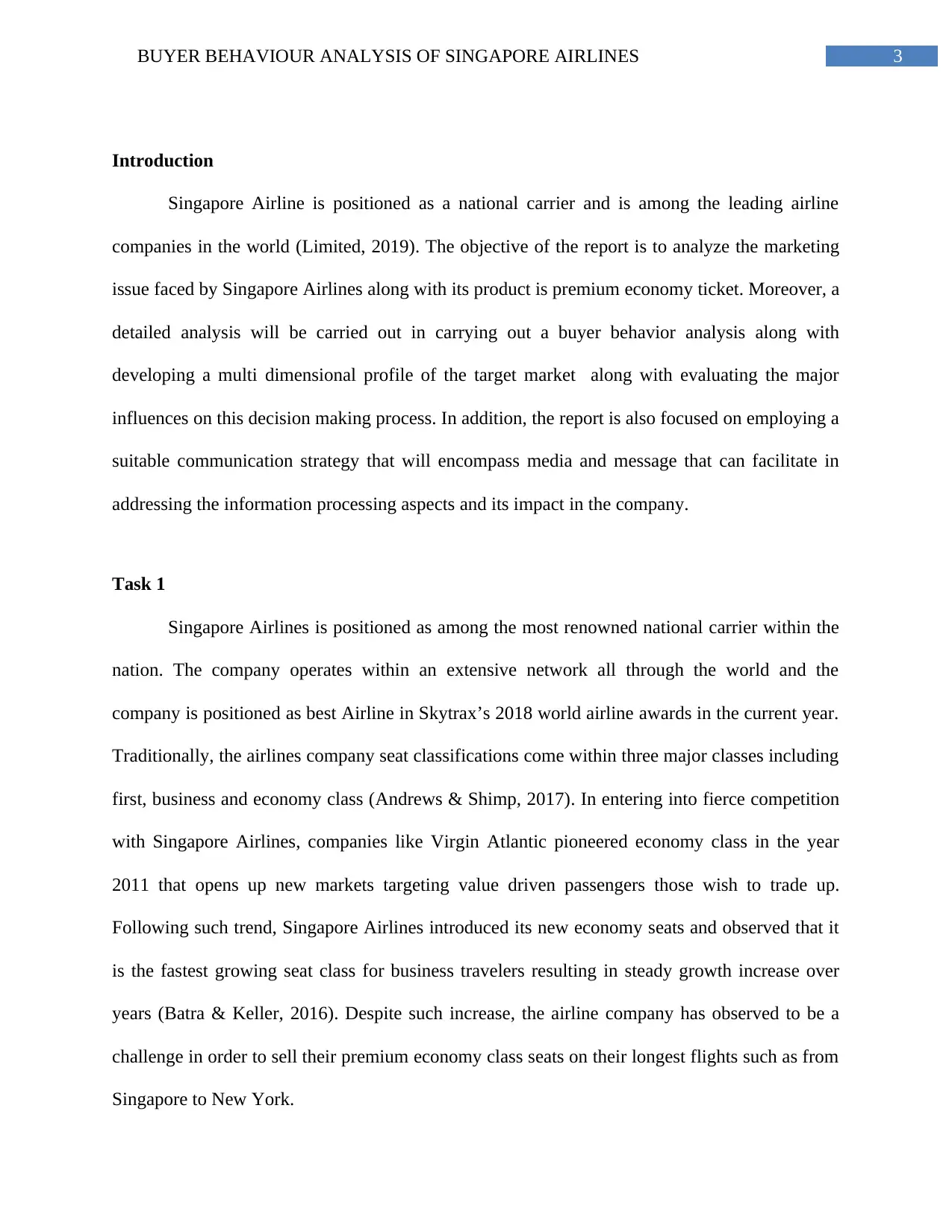
3BUYER BEHAVIOUR ANALYSIS OF SINGAPORE AIRLINES
Introduction
Singapore Airline is positioned as a national carrier and is among the leading airline
companies in the world (Limited, 2019). The objective of the report is to analyze the marketing
issue faced by Singapore Airlines along with its product is premium economy ticket. Moreover, a
detailed analysis will be carried out in carrying out a buyer behavior analysis along with
developing a multi dimensional profile of the target market along with evaluating the major
influences on this decision making process. In addition, the report is also focused on employing a
suitable communication strategy that will encompass media and message that can facilitate in
addressing the information processing aspects and its impact in the company.
Task 1
Singapore Airlines is positioned as among the most renowned national carrier within the
nation. The company operates within an extensive network all through the world and the
company is positioned as best Airline in Skytrax’s 2018 world airline awards in the current year.
Traditionally, the airlines company seat classifications come within three major classes including
first, business and economy class (Andrews & Shimp, 2017). In entering into fierce competition
with Singapore Airlines, companies like Virgin Atlantic pioneered economy class in the year
2011 that opens up new markets targeting value driven passengers those wish to trade up.
Following such trend, Singapore Airlines introduced its new economy seats and observed that it
is the fastest growing seat class for business travelers resulting in steady growth increase over
years (Batra & Keller, 2016). Despite such increase, the airline company has observed to be a
challenge in order to sell their premium economy class seats on their longest flights such as from
Singapore to New York.
Introduction
Singapore Airline is positioned as a national carrier and is among the leading airline
companies in the world (Limited, 2019). The objective of the report is to analyze the marketing
issue faced by Singapore Airlines along with its product is premium economy ticket. Moreover, a
detailed analysis will be carried out in carrying out a buyer behavior analysis along with
developing a multi dimensional profile of the target market along with evaluating the major
influences on this decision making process. In addition, the report is also focused on employing a
suitable communication strategy that will encompass media and message that can facilitate in
addressing the information processing aspects and its impact in the company.
Task 1
Singapore Airlines is positioned as among the most renowned national carrier within the
nation. The company operates within an extensive network all through the world and the
company is positioned as best Airline in Skytrax’s 2018 world airline awards in the current year.
Traditionally, the airlines company seat classifications come within three major classes including
first, business and economy class (Andrews & Shimp, 2017). In entering into fierce competition
with Singapore Airlines, companies like Virgin Atlantic pioneered economy class in the year
2011 that opens up new markets targeting value driven passengers those wish to trade up.
Following such trend, Singapore Airlines introduced its new economy seats and observed that it
is the fastest growing seat class for business travelers resulting in steady growth increase over
years (Batra & Keller, 2016). Despite such increase, the airline company has observed to be a
challenge in order to sell their premium economy class seats on their longest flights such as from
Singapore to New York.
Paraphrase This Document
Need a fresh take? Get an instant paraphrase of this document with our AI Paraphraser

4BUYER BEHAVIOUR ANALYSIS OF SINGAPORE AIRLINES
Task 2
Multi Dimensional Profile of Target Market
The target audience profiling is conducted for the Singapore Airlines Economy tickets in
order to develop suitable communication strategy for them (Bigne, Andreu, Hernandez & Ruiz,
2018).
Demographics: The target consumers are business travelers that include the managers
and the senior managers. This target market is above the age group of 25 years and in the
year 2017 the overall outbound by these consumers by year is recorded to be 8,100,687
(Camilleri, 2018).
Geographic: At the centre of CBD is observed to be the Raffles Place, the internationally
renowned financial hub of Singapore in which the most prestigious office developments
are observed to reside. Served by the Raffles Place MRT station, the average count of
daily passenger is observed to be around 89,000 people (Coursaris, van Osch & Balogh,
2016).
Psychographics: Among the target consumers of Singapore Airlines, 69% is observed o
have freedom to choose their choice of airlines. In addition, 41% of the target consumers
are observed to fly low-cost carriers for the business purpose (Andrew, 2018).
Behavioral: Among the target consumers of Singapore Airlines, 87% of passengers
made online travel bookings, 60% of the business trips encompass leisure options and
60% are observed to be open to post trip recommendations for the reason that they are
likely to return to the same destination (Chhabra, 2015).
Task 2
Multi Dimensional Profile of Target Market
The target audience profiling is conducted for the Singapore Airlines Economy tickets in
order to develop suitable communication strategy for them (Bigne, Andreu, Hernandez & Ruiz,
2018).
Demographics: The target consumers are business travelers that include the managers
and the senior managers. This target market is above the age group of 25 years and in the
year 2017 the overall outbound by these consumers by year is recorded to be 8,100,687
(Camilleri, 2018).
Geographic: At the centre of CBD is observed to be the Raffles Place, the internationally
renowned financial hub of Singapore in which the most prestigious office developments
are observed to reside. Served by the Raffles Place MRT station, the average count of
daily passenger is observed to be around 89,000 people (Coursaris, van Osch & Balogh,
2016).
Psychographics: Among the target consumers of Singapore Airlines, 69% is observed o
have freedom to choose their choice of airlines. In addition, 41% of the target consumers
are observed to fly low-cost carriers for the business purpose (Andrew, 2018).
Behavioral: Among the target consumers of Singapore Airlines, 87% of passengers
made online travel bookings, 60% of the business trips encompass leisure options and
60% are observed to be open to post trip recommendations for the reason that they are
likely to return to the same destination (Chhabra, 2015).

5BUYER BEHAVIOUR ANALYSIS OF SINGAPORE AIRLINES
Archetypes: Through observing the target consumers of Singapore Airlines, it is
gathered that 17% are saver seekers, 27% are miles maximize, 35% are stereotypical suits
and 21% are service seekers.
Buying Behavior of Target Market
Based on the model indicated below, the consumers buying prices focused on Singapore
Airlines are indicated under:
Figure 1: Blackwell, Miniard and Engel Analytical Framework
(Source: Gannage & Burton, 2016)
Problem Recognition- The consumers are aware of competitors like Scoot and Budget
Airlines and the external communication from company through advertisement on social
media. The group influences includes company policy, business partners and world
perceive (Gannage & Burton, 2016).
Information Search- This includes internal memory based on the brand familiarity along
with the airline brands such as Silk Air and Scoot. They are also certain website brands
Archetypes: Through observing the target consumers of Singapore Airlines, it is
gathered that 17% are saver seekers, 27% are miles maximize, 35% are stereotypical suits
and 21% are service seekers.
Buying Behavior of Target Market
Based on the model indicated below, the consumers buying prices focused on Singapore
Airlines are indicated under:
Figure 1: Blackwell, Miniard and Engel Analytical Framework
(Source: Gannage & Burton, 2016)
Problem Recognition- The consumers are aware of competitors like Scoot and Budget
Airlines and the external communication from company through advertisement on social
media. The group influences includes company policy, business partners and world
perceive (Gannage & Burton, 2016).
Information Search- This includes internal memory based on the brand familiarity along
with the airline brands such as Silk Air and Scoot. They are also certain website brands
⊘ This is a preview!⊘
Do you want full access?
Subscribe today to unlock all pages.

Trusted by 1+ million students worldwide

6BUYER BEHAVIOUR ANALYSIS OF SINGAPORE AIRLINES
such as booking.com and sky scanner. The external sources from which consumers can
attain information from external sources such as Travel Agents.
Evaluation of Alternatives: The objectives criteria considers priorities for the business
travelers in Asia that considers convenient flight times, direct flights, value for money,
comfortable seats, valued as consumer along with offering award winning services (He &
Balmer, 2017). The subjective criteria set by consumers on considering alternatives
selection includes Singapore branding and publicity, maintaining service excellence and
attaining several recognition awards.
Value for
Money
Convenient
Flight Timings
Comfort Baggage
Allowance
Economy 5 times daily In-flight
entertainment-
28 cm
Premium
Economy
$ 2400 5 times daily In-flight
entertainment-
34 cm
35 kg
Business $ 4919 5 times daily In-flight
entertainment-
46 cm
40 kg
Divestment- This is not applicable for the reason that Singapore Airlines e-ticket
purchase along with used or postponed to the next trip with considered penalty of USD
50= SGD 69.
such as booking.com and sky scanner. The external sources from which consumers can
attain information from external sources such as Travel Agents.
Evaluation of Alternatives: The objectives criteria considers priorities for the business
travelers in Asia that considers convenient flight times, direct flights, value for money,
comfortable seats, valued as consumer along with offering award winning services (He &
Balmer, 2017). The subjective criteria set by consumers on considering alternatives
selection includes Singapore branding and publicity, maintaining service excellence and
attaining several recognition awards.
Value for
Money
Convenient
Flight Timings
Comfort Baggage
Allowance
Economy 5 times daily In-flight
entertainment-
28 cm
Premium
Economy
$ 2400 5 times daily In-flight
entertainment-
34 cm
35 kg
Business $ 4919 5 times daily In-flight
entertainment-
46 cm
40 kg
Divestment- This is not applicable for the reason that Singapore Airlines e-ticket
purchase along with used or postponed to the next trip with considered penalty of USD
50= SGD 69.
Paraphrase This Document
Need a fresh take? Get an instant paraphrase of this document with our AI Paraphraser
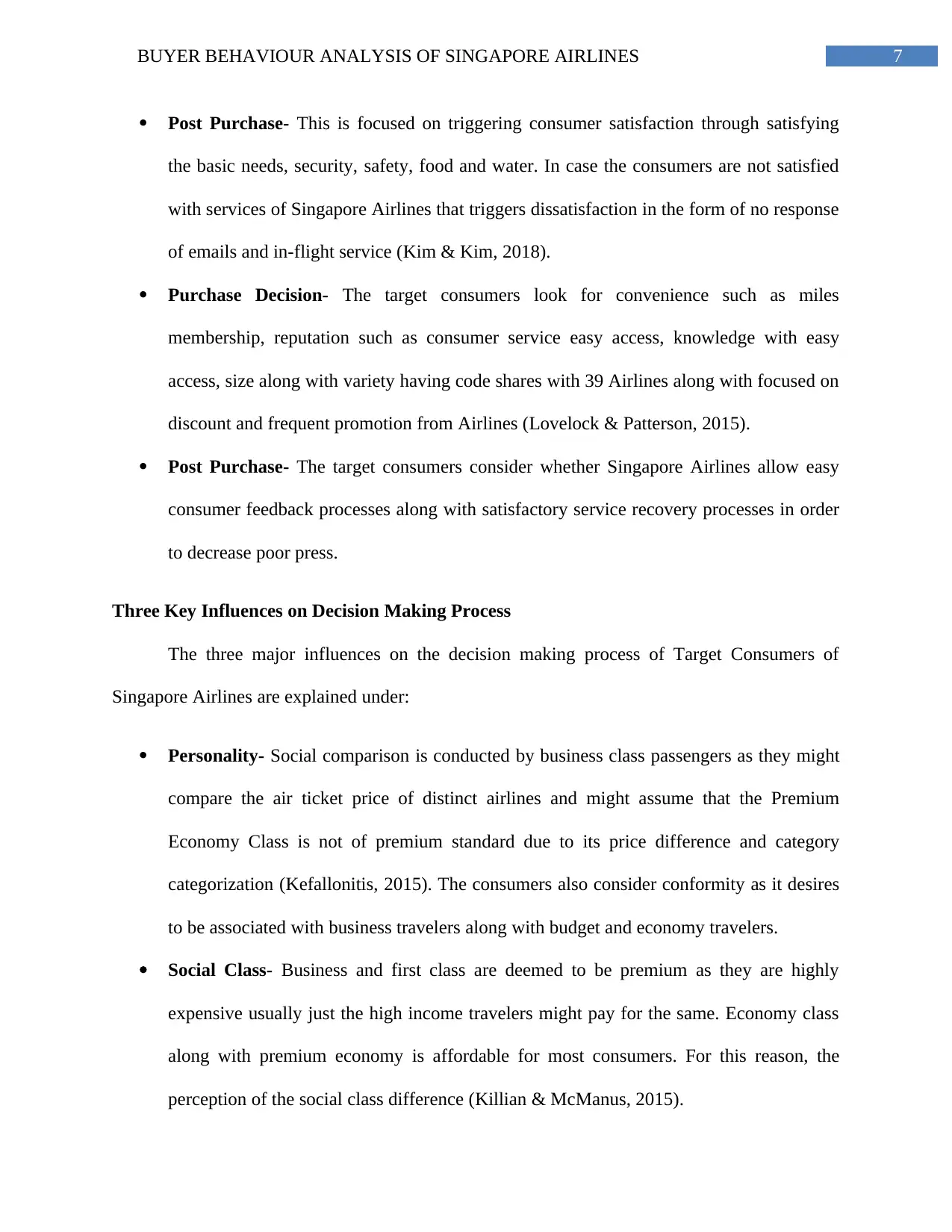
7BUYER BEHAVIOUR ANALYSIS OF SINGAPORE AIRLINES
Post Purchase- This is focused on triggering consumer satisfaction through satisfying
the basic needs, security, safety, food and water. In case the consumers are not satisfied
with services of Singapore Airlines that triggers dissatisfaction in the form of no response
of emails and in-flight service (Kim & Kim, 2018).
Purchase Decision- The target consumers look for convenience such as miles
membership, reputation such as consumer service easy access, knowledge with easy
access, size along with variety having code shares with 39 Airlines along with focused on
discount and frequent promotion from Airlines (Lovelock & Patterson, 2015).
Post Purchase- The target consumers consider whether Singapore Airlines allow easy
consumer feedback processes along with satisfactory service recovery processes in order
to decrease poor press.
Three Key Influences on Decision Making Process
The three major influences on the decision making process of Target Consumers of
Singapore Airlines are explained under:
Personality- Social comparison is conducted by business class passengers as they might
compare the air ticket price of distinct airlines and might assume that the Premium
Economy Class is not of premium standard due to its price difference and category
categorization (Kefallonitis, 2015). The consumers also consider conformity as it desires
to be associated with business travelers along with budget and economy travelers.
Social Class- Business and first class are deemed to be premium as they are highly
expensive usually just the high income travelers might pay for the same. Economy class
along with premium economy is affordable for most consumers. For this reason, the
perception of the social class difference (Killian & McManus, 2015).
Post Purchase- This is focused on triggering consumer satisfaction through satisfying
the basic needs, security, safety, food and water. In case the consumers are not satisfied
with services of Singapore Airlines that triggers dissatisfaction in the form of no response
of emails and in-flight service (Kim & Kim, 2018).
Purchase Decision- The target consumers look for convenience such as miles
membership, reputation such as consumer service easy access, knowledge with easy
access, size along with variety having code shares with 39 Airlines along with focused on
discount and frequent promotion from Airlines (Lovelock & Patterson, 2015).
Post Purchase- The target consumers consider whether Singapore Airlines allow easy
consumer feedback processes along with satisfactory service recovery processes in order
to decrease poor press.
Three Key Influences on Decision Making Process
The three major influences on the decision making process of Target Consumers of
Singapore Airlines are explained under:
Personality- Social comparison is conducted by business class passengers as they might
compare the air ticket price of distinct airlines and might assume that the Premium
Economy Class is not of premium standard due to its price difference and category
categorization (Kefallonitis, 2015). The consumers also consider conformity as it desires
to be associated with business travelers along with budget and economy travelers.
Social Class- Business and first class are deemed to be premium as they are highly
expensive usually just the high income travelers might pay for the same. Economy class
along with premium economy is affordable for most consumers. For this reason, the
perception of the social class difference (Killian & McManus, 2015).
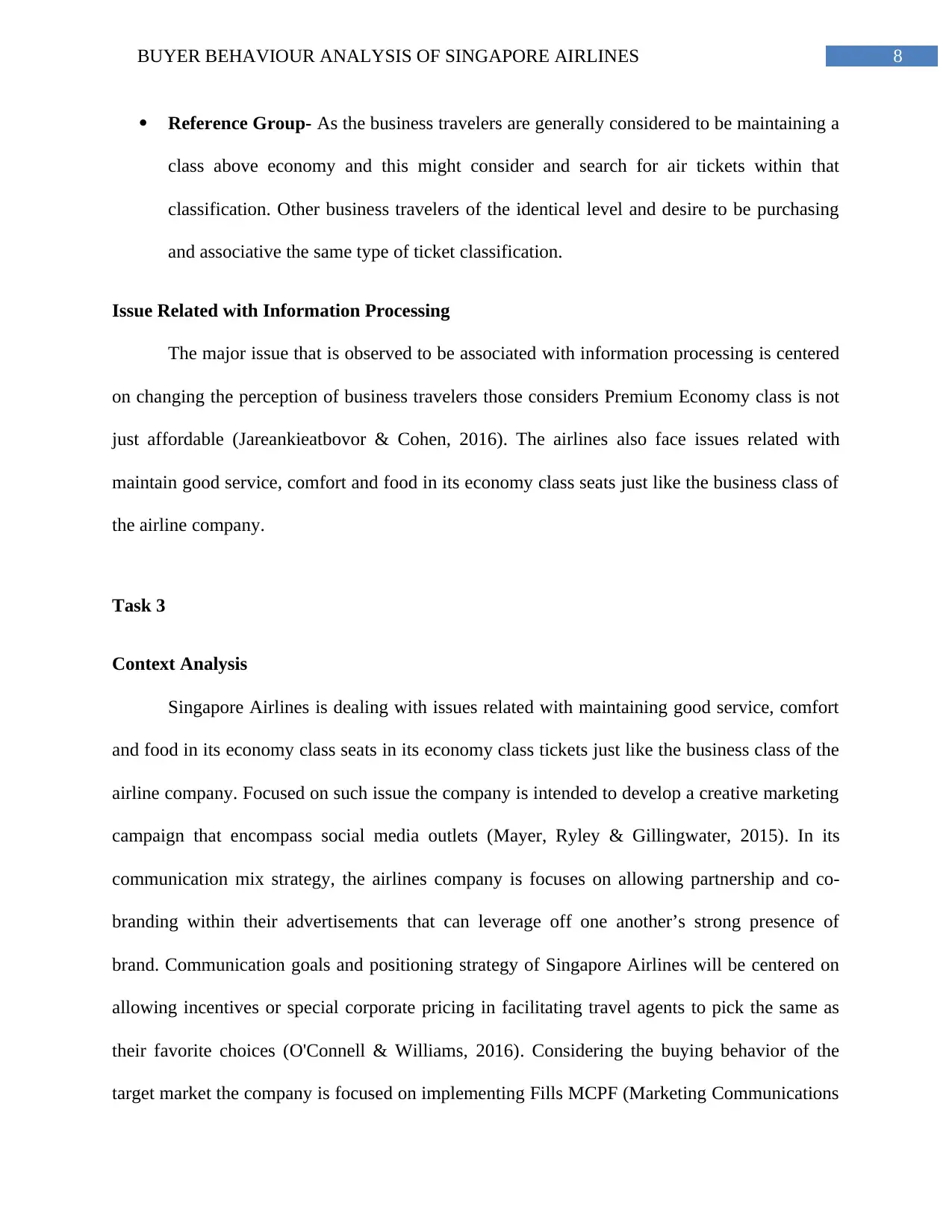
8BUYER BEHAVIOUR ANALYSIS OF SINGAPORE AIRLINES
Reference Group- As the business travelers are generally considered to be maintaining a
class above economy and this might consider and search for air tickets within that
classification. Other business travelers of the identical level and desire to be purchasing
and associative the same type of ticket classification.
Issue Related with Information Processing
The major issue that is observed to be associated with information processing is centered
on changing the perception of business travelers those considers Premium Economy class is not
just affordable (Jareankieatbovor & Cohen, 2016). The airlines also face issues related with
maintain good service, comfort and food in its economy class seats just like the business class of
the airline company.
Task 3
Context Analysis
Singapore Airlines is dealing with issues related with maintaining good service, comfort
and food in its economy class seats in its economy class tickets just like the business class of the
airline company. Focused on such issue the company is intended to develop a creative marketing
campaign that encompass social media outlets (Mayer, Ryley & Gillingwater, 2015). In its
communication mix strategy, the airlines company is focuses on allowing partnership and co-
branding within their advertisements that can leverage off one another’s strong presence of
brand. Communication goals and positioning strategy of Singapore Airlines will be centered on
allowing incentives or special corporate pricing in facilitating travel agents to pick the same as
their favorite choices (O'Connell & Williams, 2016). Considering the buying behavior of the
target market the company is focused on implementing Fills MCPF (Marketing Communications
Reference Group- As the business travelers are generally considered to be maintaining a
class above economy and this might consider and search for air tickets within that
classification. Other business travelers of the identical level and desire to be purchasing
and associative the same type of ticket classification.
Issue Related with Information Processing
The major issue that is observed to be associated with information processing is centered
on changing the perception of business travelers those considers Premium Economy class is not
just affordable (Jareankieatbovor & Cohen, 2016). The airlines also face issues related with
maintain good service, comfort and food in its economy class seats just like the business class of
the airline company.
Task 3
Context Analysis
Singapore Airlines is dealing with issues related with maintaining good service, comfort
and food in its economy class seats in its economy class tickets just like the business class of the
airline company. Focused on such issue the company is intended to develop a creative marketing
campaign that encompass social media outlets (Mayer, Ryley & Gillingwater, 2015). In its
communication mix strategy, the airlines company is focuses on allowing partnership and co-
branding within their advertisements that can leverage off one another’s strong presence of
brand. Communication goals and positioning strategy of Singapore Airlines will be centered on
allowing incentives or special corporate pricing in facilitating travel agents to pick the same as
their favorite choices (O'Connell & Williams, 2016). Considering the buying behavior of the
target market the company is focused on implementing Fills MCPF (Marketing Communications
⊘ This is a preview!⊘
Do you want full access?
Subscribe today to unlock all pages.

Trusted by 1+ million students worldwide

9BUYER BEHAVIOUR ANALYSIS OF SINGAPORE AIRLINES
Planning Framework) in its communication mix strategy that will address traveler’s needs along
with displaying the same within their advertisements. The airlines must also focus its
communication strategy in allowing seamless access in managing booking page for the process
by means of travel agencies or third party websites for ensuring simple future repurchase
decisions (Seo & Park, 2018). In order to promote its economy class tickets successfully,
Singapore Airlines will facilitate simple consumer feedback processes along with satisfactory
processes of service recovery.
Communication Goals and Positioning Strategy
The communication goals of Singapore Airlines in increasing the sales of economy class
tickets among its travelers are indicated below:
Awareness: To increase the product awareness that the economy class tickets can be at
affordable price tags that can facilitate 45% viewership from the market size of 1.14mil
business travelers within the six months of the communication mix campaign launch
(Shaw, 2016).
To attain increased sales target: The objective is to allow 1% purchase rate of the
overall market size and the anticipated sales revenue after launch of the six months
marketing campaign $ 20155392.
In addition, the specified marketing objectives is evaluated through analyzing sizeable,
definable, relevant and reachable aspects of such objectives that can ensure increased
effectiveness of such marketing communications campaign (Wang, Kao & Ngamsiriudom,
2017). These aspects aligned with the defined marketing communications objectives are
explained under:
Planning Framework) in its communication mix strategy that will address traveler’s needs along
with displaying the same within their advertisements. The airlines must also focus its
communication strategy in allowing seamless access in managing booking page for the process
by means of travel agencies or third party websites for ensuring simple future repurchase
decisions (Seo & Park, 2018). In order to promote its economy class tickets successfully,
Singapore Airlines will facilitate simple consumer feedback processes along with satisfactory
processes of service recovery.
Communication Goals and Positioning Strategy
The communication goals of Singapore Airlines in increasing the sales of economy class
tickets among its travelers are indicated below:
Awareness: To increase the product awareness that the economy class tickets can be at
affordable price tags that can facilitate 45% viewership from the market size of 1.14mil
business travelers within the six months of the communication mix campaign launch
(Shaw, 2016).
To attain increased sales target: The objective is to allow 1% purchase rate of the
overall market size and the anticipated sales revenue after launch of the six months
marketing campaign $ 20155392.
In addition, the specified marketing objectives is evaluated through analyzing sizeable,
definable, relevant and reachable aspects of such objectives that can ensure increased
effectiveness of such marketing communications campaign (Wang, Kao & Ngamsiriudom,
2017). These aspects aligned with the defined marketing communications objectives are
explained under:
Paraphrase This Document
Need a fresh take? Get an instant paraphrase of this document with our AI Paraphraser
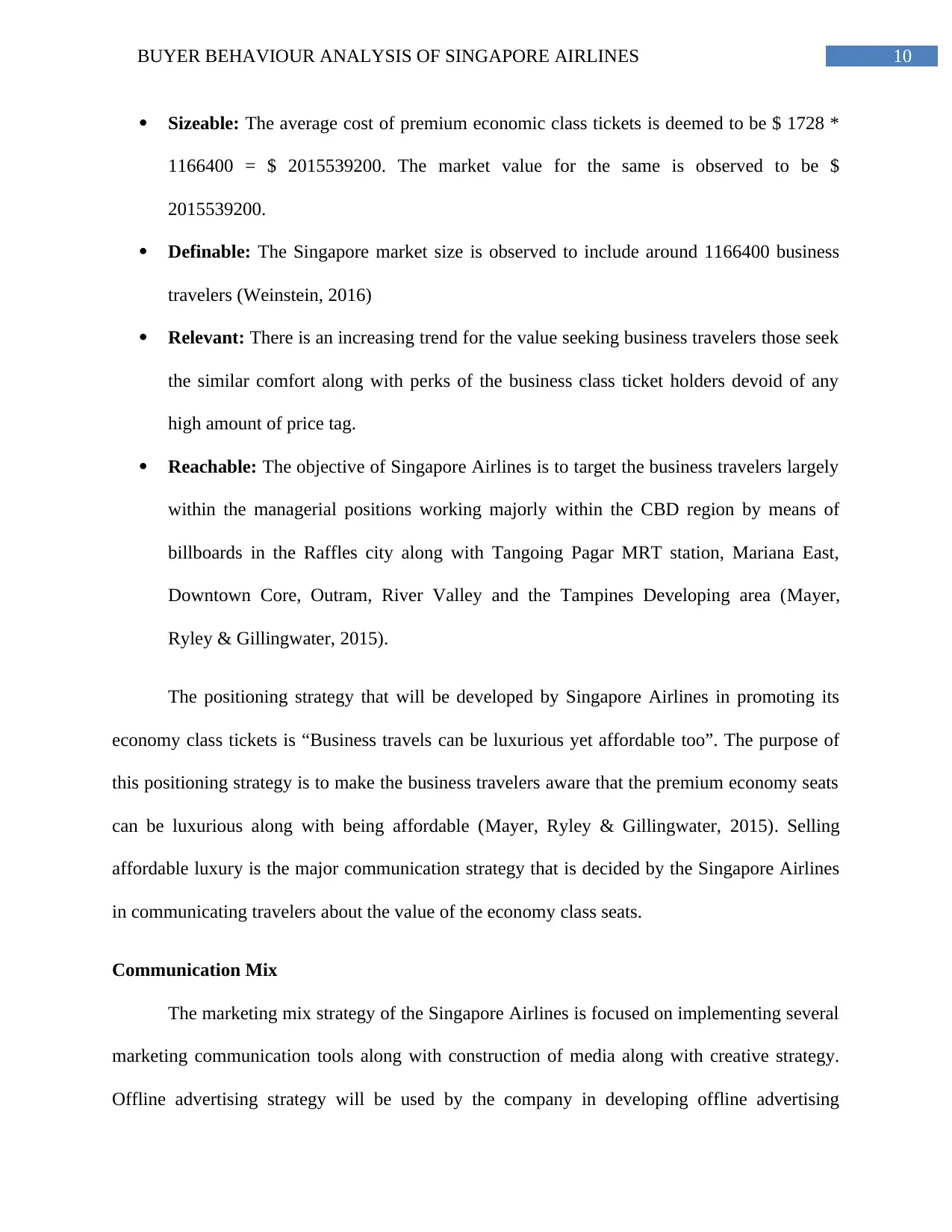
10BUYER BEHAVIOUR ANALYSIS OF SINGAPORE AIRLINES
Sizeable: The average cost of premium economic class tickets is deemed to be $ 1728 *
1166400 = $ 2015539200. The market value for the same is observed to be $
2015539200.
Definable: The Singapore market size is observed to include around 1166400 business
travelers (Weinstein, 2016)
Relevant: There is an increasing trend for the value seeking business travelers those seek
the similar comfort along with perks of the business class ticket holders devoid of any
high amount of price tag.
Reachable: The objective of Singapore Airlines is to target the business travelers largely
within the managerial positions working majorly within the CBD region by means of
billboards in the Raffles city along with Tangoing Pagar MRT station, Mariana East,
Downtown Core, Outram, River Valley and the Tampines Developing area (Mayer,
Ryley & Gillingwater, 2015).
The positioning strategy that will be developed by Singapore Airlines in promoting its
economy class tickets is “Business travels can be luxurious yet affordable too”. The purpose of
this positioning strategy is to make the business travelers aware that the premium economy seats
can be luxurious along with being affordable (Mayer, Ryley & Gillingwater, 2015). Selling
affordable luxury is the major communication strategy that is decided by the Singapore Airlines
in communicating travelers about the value of the economy class seats.
Communication Mix
The marketing mix strategy of the Singapore Airlines is focused on implementing several
marketing communication tools along with construction of media along with creative strategy.
Offline advertising strategy will be used by the company in developing offline advertising
Sizeable: The average cost of premium economic class tickets is deemed to be $ 1728 *
1166400 = $ 2015539200. The market value for the same is observed to be $
2015539200.
Definable: The Singapore market size is observed to include around 1166400 business
travelers (Weinstein, 2016)
Relevant: There is an increasing trend for the value seeking business travelers those seek
the similar comfort along with perks of the business class ticket holders devoid of any
high amount of price tag.
Reachable: The objective of Singapore Airlines is to target the business travelers largely
within the managerial positions working majorly within the CBD region by means of
billboards in the Raffles city along with Tangoing Pagar MRT station, Mariana East,
Downtown Core, Outram, River Valley and the Tampines Developing area (Mayer,
Ryley & Gillingwater, 2015).
The positioning strategy that will be developed by Singapore Airlines in promoting its
economy class tickets is “Business travels can be luxurious yet affordable too”. The purpose of
this positioning strategy is to make the business travelers aware that the premium economy seats
can be luxurious along with being affordable (Mayer, Ryley & Gillingwater, 2015). Selling
affordable luxury is the major communication strategy that is decided by the Singapore Airlines
in communicating travelers about the value of the economy class seats.
Communication Mix
The marketing mix strategy of the Singapore Airlines is focused on implementing several
marketing communication tools along with construction of media along with creative strategy.
Offline advertising strategy will be used by the company in developing offline advertising
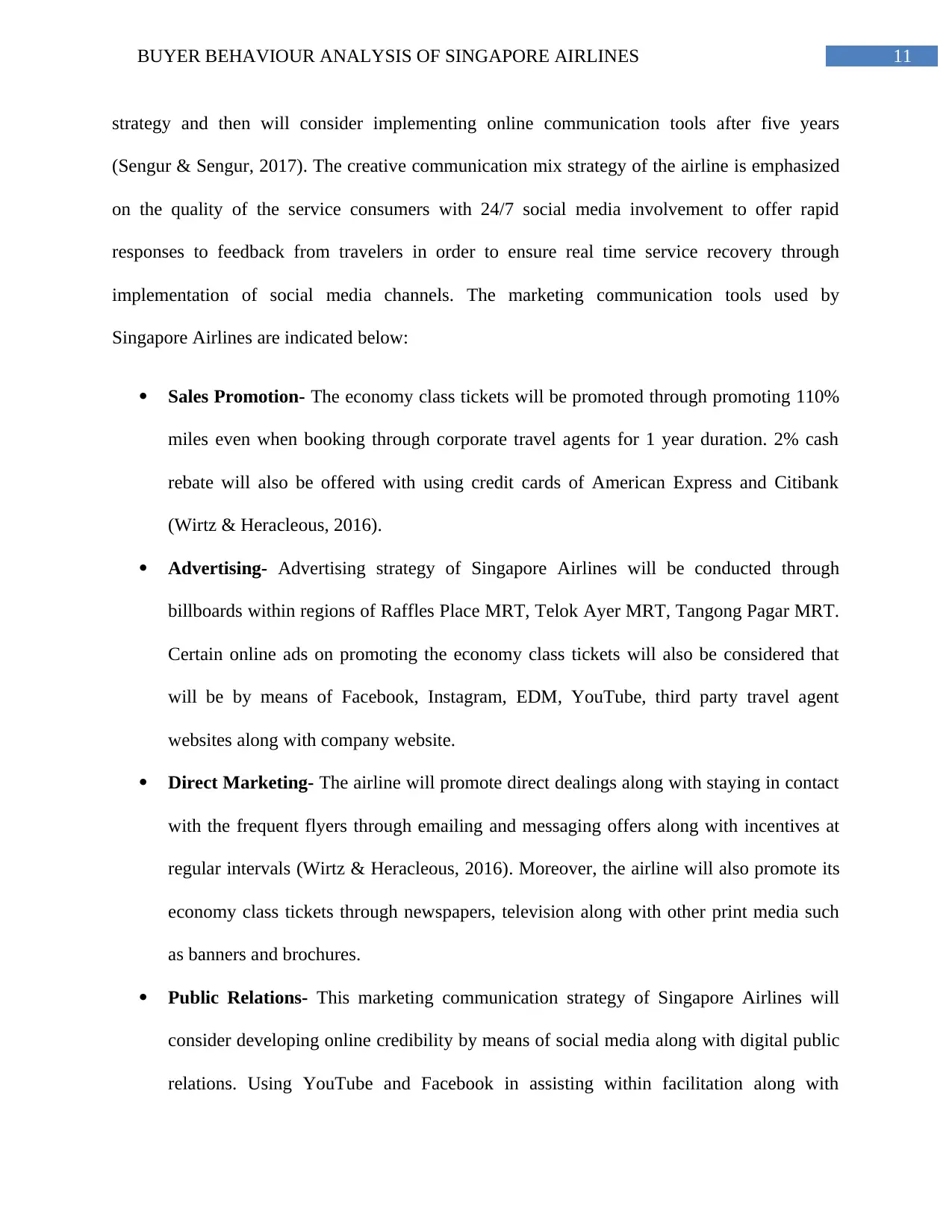
11BUYER BEHAVIOUR ANALYSIS OF SINGAPORE AIRLINES
strategy and then will consider implementing online communication tools after five years
(Sengur & Sengur, 2017). The creative communication mix strategy of the airline is emphasized
on the quality of the service consumers with 24/7 social media involvement to offer rapid
responses to feedback from travelers in order to ensure real time service recovery through
implementation of social media channels. The marketing communication tools used by
Singapore Airlines are indicated below:
Sales Promotion- The economy class tickets will be promoted through promoting 110%
miles even when booking through corporate travel agents for 1 year duration. 2% cash
rebate will also be offered with using credit cards of American Express and Citibank
(Wirtz & Heracleous, 2016).
Advertising- Advertising strategy of Singapore Airlines will be conducted through
billboards within regions of Raffles Place MRT, Telok Ayer MRT, Tangong Pagar MRT.
Certain online ads on promoting the economy class tickets will also be considered that
will be by means of Facebook, Instagram, EDM, YouTube, third party travel agent
websites along with company website.
Direct Marketing- The airline will promote direct dealings along with staying in contact
with the frequent flyers through emailing and messaging offers along with incentives at
regular intervals (Wirtz & Heracleous, 2016). Moreover, the airline will also promote its
economy class tickets through newspapers, television along with other print media such
as banners and brochures.
Public Relations- This marketing communication strategy of Singapore Airlines will
consider developing online credibility by means of social media along with digital public
relations. Using YouTube and Facebook in assisting within facilitation along with
strategy and then will consider implementing online communication tools after five years
(Sengur & Sengur, 2017). The creative communication mix strategy of the airline is emphasized
on the quality of the service consumers with 24/7 social media involvement to offer rapid
responses to feedback from travelers in order to ensure real time service recovery through
implementation of social media channels. The marketing communication tools used by
Singapore Airlines are indicated below:
Sales Promotion- The economy class tickets will be promoted through promoting 110%
miles even when booking through corporate travel agents for 1 year duration. 2% cash
rebate will also be offered with using credit cards of American Express and Citibank
(Wirtz & Heracleous, 2016).
Advertising- Advertising strategy of Singapore Airlines will be conducted through
billboards within regions of Raffles Place MRT, Telok Ayer MRT, Tangong Pagar MRT.
Certain online ads on promoting the economy class tickets will also be considered that
will be by means of Facebook, Instagram, EDM, YouTube, third party travel agent
websites along with company website.
Direct Marketing- The airline will promote direct dealings along with staying in contact
with the frequent flyers through emailing and messaging offers along with incentives at
regular intervals (Wirtz & Heracleous, 2016). Moreover, the airline will also promote its
economy class tickets through newspapers, television along with other print media such
as banners and brochures.
Public Relations- This marketing communication strategy of Singapore Airlines will
consider developing online credibility by means of social media along with digital public
relations. Using YouTube and Facebook in assisting within facilitation along with
⊘ This is a preview!⊘
Do you want full access?
Subscribe today to unlock all pages.

Trusted by 1+ million students worldwide
1 out of 24
Related Documents
Your All-in-One AI-Powered Toolkit for Academic Success.
+13062052269
info@desklib.com
Available 24*7 on WhatsApp / Email
![[object Object]](/_next/static/media/star-bottom.7253800d.svg)
Unlock your academic potential
Copyright © 2020–2025 A2Z Services. All Rights Reserved. Developed and managed by ZUCOL.





